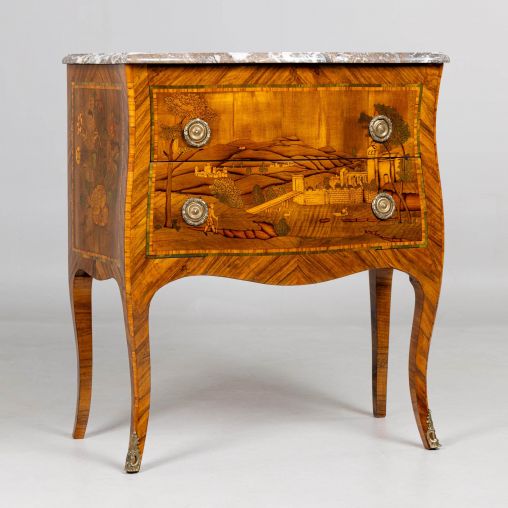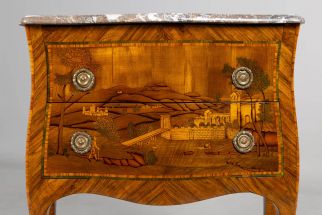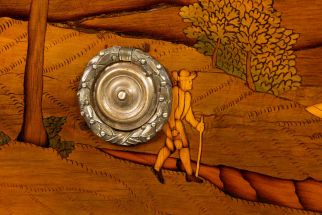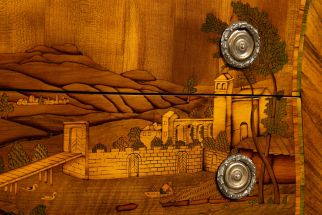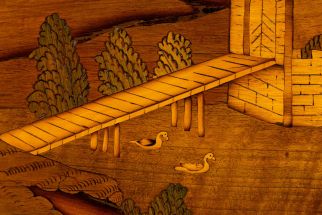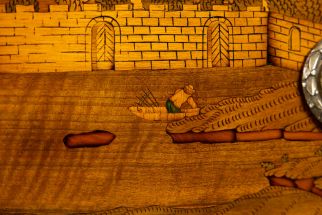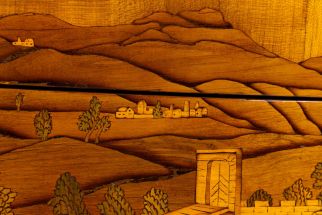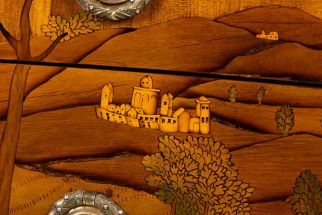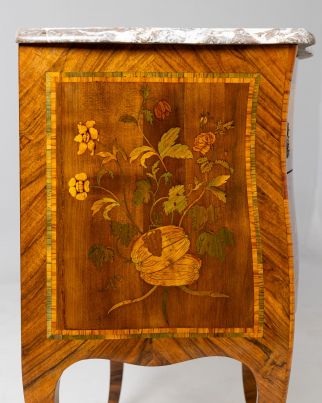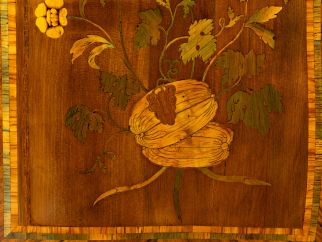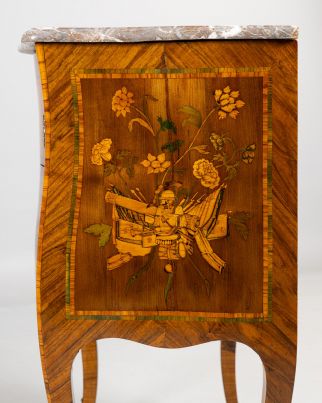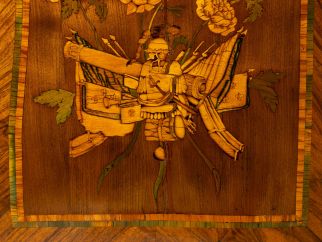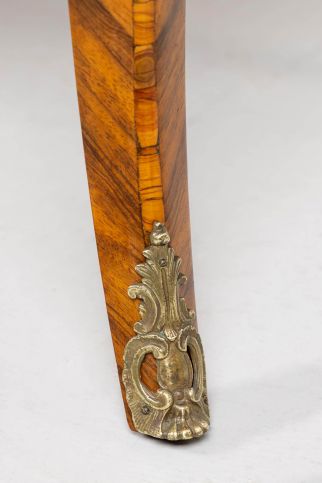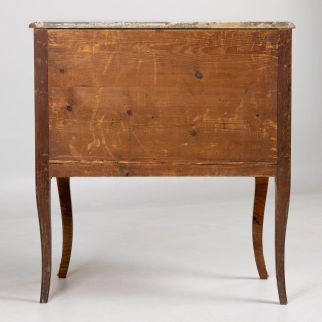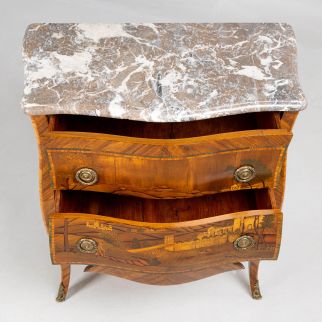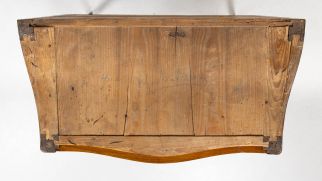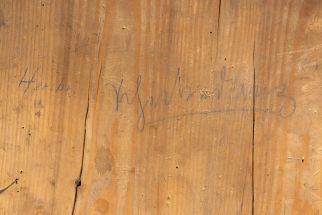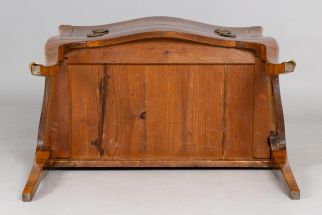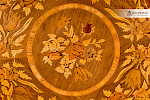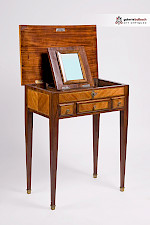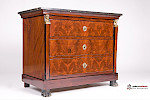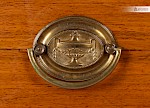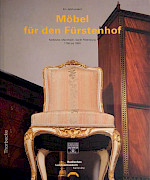Small transitional chest of drawers, Paris around 1770
France
Walnut and others
second half of 18th century
Dimensions: H x W x D: 92 x 85 x 48 cm
Description:
Dainty French chest of drawers from the 18th century with impressive marquetry.
A piece of furniture standing on curved, flared legs in bronze sabots. Due to the relatively long legs and the omission of a third drawer, the piece of furniture appears light and delicate.
The curve of the front legs continues upwards over the pilaster strips. The cross veneer on the leg edges subtly emphasises the curved lines.
The main focus is on the inlay work on the front. By skilfully laying finely engraved and fire shaded wood, the inlay artist has created a veritable work of art.
Framed by two wooden bands, we see a hiker against a rural backdrop. Against the expanse of sky depicted in plain poplar wood, mountain massifs rise up in which castle-like settlements are located. The hiker is about to pass a fortress surrounded by a moat while a fisherman is laying out his fish traps. The idyllic scenery is completed by two ducks on the water.
It can be assumed that the painting was originally much more colourful than we see it today. The blue and red tones have faded over the centuries, but the green colouring, which we can still clearly see in the plants and in the outer band of the frame, has been well preserved.
On the sides of the piece of furniture we see an arrangement of fruit and vegetable plants on the left and the attributes of war - armour, weapons, flags and fanfare instruments - on the right.
The top of the chest of drawers is topped by a loose slab of grey-beige veined marble that follows the shape of the body.
Below the top, the piece of furniture is labelled "Hersbr." and "Schickedanz". It cannot be ruled out that this refers to the Schickedanz family, who founded the mail-order company Quelle in 1927. In the early 1940s, the family residence was moved from Fürth to Hersbruck and in 1946, the first Quelle shop was opened in Hersbruck.
With the insolvency of the Quelle mail order company in 2009, personal furnishings were pledged in addition to company assets and real estate. The chest of drawers may have come from this insolvency estate.
Worth knowing:
The chest of drawers offered here is dated to the Transitional period, i.e. the transitional phase from Louis XV to Louis XVI.
The sweep and workmanship of the body are still entirely in keeping with the taste of the mid-18th century. The original fittings, on the other hand, are already clearly attributable to Classicism.
This type of chest of drawers is known as a "commode sauté" and was often made by cabinetmakers who had not yet joined the guild. Commodes of this type are therefore often not stamped, as was prescribed for masters by the guild.
Condition:
Very beautiful and well-kept condition with a classic shellac hand polish.
A very similar piece of furniture is in the possession of the Badisches Landesmuseum Karlsruhe under inventory number R21.
Please refer to the following specialised literature:
Thorbecke Verlag - Möbel für den Fürstenhof p. 120
Badisches Landesmuseum Karlsruhe - Möbel für den Fürstenhof
Article found under: Chests of drawers
Also interesting
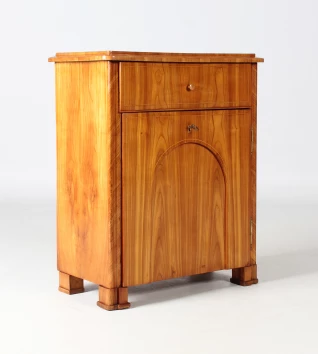
Small Biedermeier Pillar Cabinet
Saxony
Cherry tree
Biedermeier around 1835
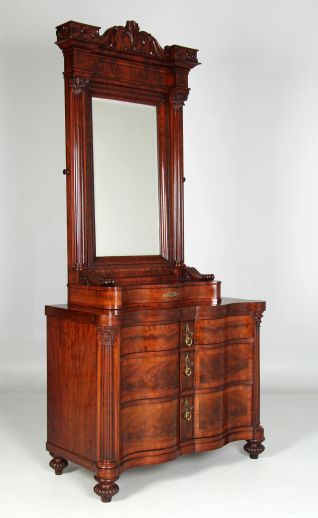
Chest of drawers with mirror
Northern Germany
Mahogany
Mid 19th century

Classicist corner cabinet
Southern Germany
Walnut, maple
Classicism around 1790
